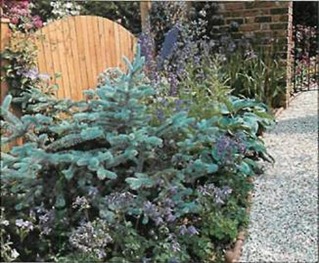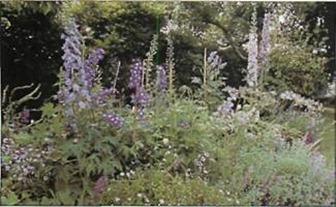





You can create an unusual and striking garden by growing plants of the same colour together, and blue is particularly effective. Use blue hues either in strategic groups or devote the whole garden to this fascinating colour.
True blue is a rare and sought-after colour in the garden. But there are many blue hues, ranging from baby-blue love-in-a-mist to rich violet-blue campanulas.
Flowers contribute most to the blue garden in spring and summer, but berries and even foliage can continue the display through autumn and into winter. With a bit of planning, you can create a stunning show all year round. Choose plants with a range of growing habits, that provide attractive blooms, leaves or fruit at different times.

A blue-leaved conifer is an interesting feature. For a town garden, choose one of the smaller species, such as Picea pungens ‘Procumbens’ or Juniperus horizontalis ‘Glauca’. Both grow close to the ground, no higher than 45cm, with sea-blue leaves.
Juniperus squamata ‘Blue Star’ is a dwarf juniper which looks good with perennials in the border. Picea pungens ‘Globosa’ is a larger, rounded shrub, growing to 1.5m. For a specimen that provides an unusual talking point in a blue garden, try Juniperus x media ‘Blue and Gold’. This conifer is steel-blue splashed with patches of light gold.
Paulownia tomentosa has enchanting, bell-shaped flowers in May. It can grow up to 10m tall, so is best in the larger garden. It will give a good display of blooms only in a mild area as the buds form the year before and have to survive the winter to flower.
Of the medium-sized shrubs, try Buddleia davidii ‘Nanhoe Blue’ (pale blue).
There are several climbers which cover the whole range of blues.
• The pale blue wisteria (Wisteria sinensis) drops its cascades of racemes (stalked flowers) in May and looks marvellous on the side of a stone or pale brick house. Alternatively, try it as a patio plant in a terracotta pot. Wisteria takes some time to come into full bloom, but it is well worth the wait.
• There are many stunning blue species and hybrids of clematis to choose from.
For pure, deep blue flowers, try growing a climbing species of the aptly named morning glory (ipomoed). It is half hardy and produces flowers which open only in the morning and then die. Unless you have a conservatory to keep the plants in over the winter, you will probably have to raise them from seed each year.
BUYING TIP
In the Latin names of blue varieties, the term ‘glauca’ often occurs. This is the Latin word for a bluish colour which may be steel-blue or sea-blue. The term for pure blue is ‘caerulea’. Keep an eye out for these terms in plant names as they give you a clue to flower colour when selecting varieties for your garden.
 In the blue garden, bedding plants are always helpful to fill in gaps. They are particularly useful when the garden is in its early stages, and you are waiting for the larger plants to mature and fill their allotted spaces.
In the blue garden, bedding plants are always helpful to fill in gaps. They are particularly useful when the garden is in its early stages, and you are waiting for the larger plants to mature and fill their allotted spaces.
Create a superb splash of blue with half-hardy, pale blue petunias or pure, mid-blue felicia. Although ageratum flowers are more mauve than true blue, they look good edging the border in summer.
The half-hardy heliotrope has dark violet-blue or pale lavender flowers, depending on the variety. It looks like a small shrub during the summer and, as a bonus, the flowers are sweetly scented.
TIP
ADDING CONTRAST
There is no need to restrict the garden entirely to blue. Spots of different colour can make the blue plants stand out even more strongly. For example, grey-leaved or white-variegated plants go well with blue and lighten the overall colour scheme of the garden. White flowers can be used in the same way.
Copyright © www.100flowers.win Botanic Garden All Rights Reserved